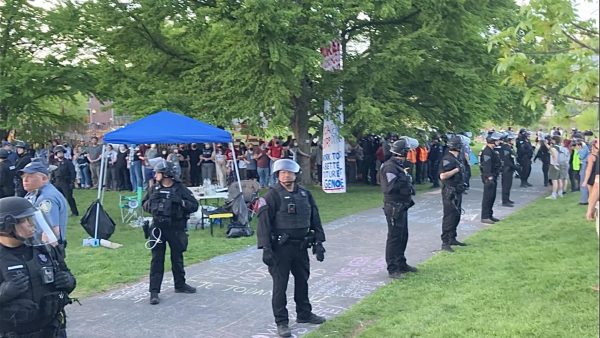UMass police and faculty host active threat training for students
Survival mindset is essential in active threat situation, police say
UMass Police Department Officer Brian Kellogg leads an active threat training at the University of Massachusetts Amherst Monday evening.
In an effort to raise awareness and prepare for a potential active threat, University of Massachusetts Amherst students gathered Monday evening to listen and discuss how to respond to an active shooter.
The event, hosted by the UMass Amherst Journalism Department in partnership with the UMass police department, emphasized taking action in an active threat situation.
UMass Police Officer Brian Kellogg led the presentation, urging students to be the person “who decides to do something” when lives are at risk.
According to the training, the aim is to gain a survival mindset, described as the state of mind where one feels prepared and confident to figure out the best course of action.
“Tell your brain to shut up and act,” Kellogg said.
UMass Professor Greeley Kyle, who teaches broadcast journalism, addressed the crowd and emphasized the importance of the training for journalism students. According to Kyle, students entering that profession may encounter active threat situations in their future careers.
“Failing to prepare is preparing to fail,” Kyle said.
UMass Journalism Department Chairwoman Kathy Roberts Forde echoed Kyle’s statement in an email to students over the weekend. In the message, Forde said Monday’s training would help students prepare for the worst, “even as we hope for and expect the best.”
“There is no need to be scared. Active shooting situations on campuses are not common,” Forde wrote. “But there is a need to be prepared.”
To prepare for an active threat situation, Kellogg said students should understand each person is “the only stakeholder” in their own safety.
“It is up to students to become prepared for this type of situation, because ultimately it is them who must react,” Kellogg said.
The officer shared videos with students and staff to visualize scenarios and figure out the best way to respond. Kellogg has been part of the department’s community outreach unit for six years and focuses on teaching people how to respond to active shooter situations.
In a video titled “Shots Fired,” Officer Nick Briggs said thinking about a situation before it happens will help victims be prepared.
There are several paths to safety and survival in an active threat situation, according to the training.
The first course of action is to make a daily habit of observing the locations of building exits in case a quick escape is necessary. According to the training, those who escape an active threat situation should call the police immediately, rather than assume someone else has.
Another option is to hide out. The training suggests those at risk lock doors, move heavy objects, be silent and spread out. It is more difficult for a shooter to attack a dispersed group than a clumped one, Kellogg said.
As a last resort, those in an active threat situation should prepare to physically take out the threat, Kellogg said. Those in danger should organize, make a plan and stick with it. The training suggested looking for hard objects to throw or attack with, and said those under attack should work together to physically disable the threat until police arrive on the scene.
Police have responded to three separate incidents of weapons reported on the UMass campus since last fall.
In October 2015, police investigated a UMass Dining worker who violated state law by bringing a firearm on campus. The employee was later terminated, according to MassLive. Months later, two Sheffield teens pulled a gun on a UMass student who tried to talk a 15-year-old female friend out of driving off with them, the Daily Hampshire Gazette reported in January.
In February, UMass issued a shelter-in-place order when a man, thought to have a gun, assaulted and robbed a student in a residence hall on campus. The precaution essentially shut down the campus for three hours.
During an investigation, officials determined the student had been struck with a BB gun — first thought to be a pistol — during the incident, according to the Daily Hampshire Gazette.
At the time of the February gun scare, police observed students who disregarded the shelter-in-place measure, Kellogg said. According to Kellogg, some students continued exercising at the UMass Campus Recreation Center that night despite the warning. The students were “stuck in their normal process,” he said.
But in an active threat situation, Kellogg said students should go abandon routine and go with their instincts.
Suspicious activity on the UMass Amherst campus can be reported to the UMass Police Department by calling 413-545-3111. Additionally, students may subscribe to UMass Alerts to receive emergency text messages from the university.
Caeli Chesin can be reached at [email protected].











